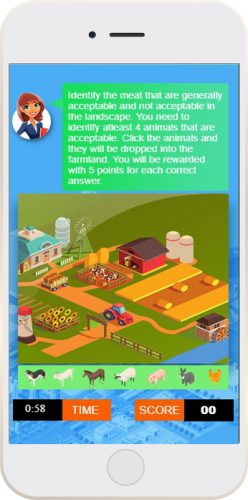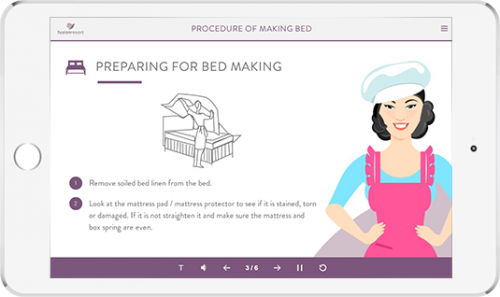Wondering whether and how you can make your Microlearning Interventions work to achieve your training goals? Check how you can make your Microlearning Interventions work to achieve your training goals and help IDs and L&D Managers understand how to implement.
Microlearning Interventions: How To Achieve Your Training Goals
When microlearning was invented or rather discovered, it was called bite-sized learning. I wondered if it had something to do with a “tea time” games that many people indulge in. No pun intended.
Story So Far
Soon, the term caught the attention of Instructional Designers and L&D Managers, and they thought it was a good thing to have in your armory. Many IDs assumed that it was the panacea for all the ills that plagued the world of training. This was based on a notion that human memory can hold only so much information at a given point in time and therefore bite-sized learning addresses this head-on.
The Fallacy Of Attention Spans
It was hailed as the discovery of the decade and almost everyone latched on to the idea. However, here lied the fallacy. The theory was based on the idea that people have limited attention spans and human memory can only hold so much information. This, as pointed out by many experts, is pseudoscience and has no real-world empirical basis. I was recently discussing the same aspects with a leading expert and he confirmed that “if learners love something, they will spend hours on it”. Another fallacy that had taken shape albeit for a shorter period was that mobile learning equals microlearning.
Where We Stand Now?
So, as we stand today, we need to put away the idea of attention spans for good when it comes to microlearning. Also, we realize that microlearning and mobile learning are 2 different beasts! Microlearning comprises small nuggets of learning, usually spanning only a few minutes of seat time targeting a specific learning objective. Mobile learning, on the other hand, is learning that is accessible through your smartphones or tablets and is basically, learning on-the-go. Mobile learning naturally utilizes concepts of microlearning, but we can have microlearning concepts applied to traditional eLearning as well.
Microlearning At Work
Consider these examples:
- Watching simple “How-To” videos on YouTube
- Learning through picture charts or flashcards
- Working through series of Practice Tests
- Receiving e-mails on “Word for the Day”
Are these examples of microlearning or just short nuggets of information?
So, what really constitutes microlearning? What are the guidelines that we need to adhere to?
Guidelines
My understanding is that microlearning must incorporate as many of the following guidelines as possible to be truly “micro” in learning:
- A standalone piece of content
- Focus on specific learning outcome
- Uses rich multimedia, game-based strategy, and so on to engage the learners
A Standalone Piece Of Content
My experience says that microlearning needs to be treated as an individual unit of learning piece. It needs to be mapped to a specific topic.
Instead of talking about histories, the short burst of learning needs to address a specific need or a problem. This little universe needs to have its own introduction, learning objective, the “how-to” content piece, an activity, and a summary.
It should not be a piece of a large universe. In other words, it need not be a part of a large course or a course that has multiple cross-references.
A Well-Thought-Out Learning Objective
The learning objective should be clearly defined basis the content that needs to be taught. Of the various ID models, I like the 4-mat model. I think it is quite relevant for microlearning. The 4 aspects are “what”, “why”, “how”, and “what if” can be easily used to create an impactful microlearning course. If we focus on what and how part of the subject, then it addresses the requirement well.
Using Rich Multimedia Or Game Based Strategy
While we may opt to adopt mobile learning, we may not be necessarily delivering effective learning. This is because, when we need to train our learners on a vast volume of subject material or when the subject needs to be studied in great details, microlearning is just not suitable. For example, learning to speak certain words or general communication in a particular language is perfect for a microlearning, but when you need to learn the complete language, then, it’s eLearning that comes handy.
You will also avoid microlearning when you want your learners to connect various interconnected topics together in a coherent, ‘macro’ picture. Microlearning, is just well, micro in every sense.
You will also avoid microlearning when you want your learners to connect various interconnected topics together in a coherent, ‘macro’ picture. Microlearning, is just well, micro in every sense.
Case Studies
1. The customer wanted a short course on the food processing that would help learners understand how food is sourced, processed and marketed. For this, we created a short microlearning course with the requisite content and interesting activities to sensitize the learners about the entire process. This was smartphone-only delivery.

2. The customer wanted to train their employees on the basic concepts of housekeeping. We created a microlearning module that covered aspects, such as how to make a bed and an associated activity.

Conclusion
At Tesseract Learning, we have implemented microlearning using unique activity-based nuggets, game-based nuggets and importantly being device agnostic. Learners get the same experience, whether on a PC, a tablet, or a smartphone.
Our ID Strategists are the right experts you can turn to for all such doubts. At Tesseract Learning, our ID Strategists will ensure that your custom learning, mobile learning, or microlearning matches the best standards available in the market.
Do also share your feedback and suggestions on this article in the comments section.
Microlearning Interventions: How To Achieve Your Training Goals
When microlearning was invented or rather discovered, it was called bite-sized learning. I wondered if it had something to do with a “tea time” games that many people indulge in. No pun intended.
Story So Far
Soon, the term caught the attention of Instructional Designers and L&D Managers, and they thought it was a good thing to have in your armory. Many IDs assumed that it was the panacea for all the ills that plagued the world of training. This was based on a notion that human memory can hold only so much information at a given point in time and therefore bite-sized learning addresses this head-on.
The Fallacy Of Attention Spans
It was hailed as the discovery of the decade and almost everyone latched on to the idea. However, here lied the fallacy. The theory was based on the idea that people have limited attention spans and human memory can only hold so much information. This, as pointed out by many experts, is pseudoscience and has no real-world empirical basis. I was recently discussing the same aspects with a leading expert and he confirmed that “if learners love something, they will spend hours on it”. Another fallacy that had taken shape albeit for a shorter period was that mobile learning equals microlearning.
Where We Stand Now?
So, as we stand today, we need to put away the idea of attention spans for good when it comes to microlearning. Also, we realize that microlearning and mobile learning are 2 different beasts! Microlearning comprises small nuggets of learning, usually spanning only a few minutes of seat time targeting a specific learning objective. Mobile learning, on the other hand, is learning that is accessible through your smartphones or tablets and is basically, learning on-the-go. Mobile learning naturally utilizes concepts of microlearning, but we can have microlearning concepts applied to traditional eLearning as well.
Microlearning At Work
Consider these examples:
- Watching simple “How-To” videos on YouTube
- Learning through picture charts or flashcards
- Working through series of Practice Tests
- Receiving e-mails on “Word for the Day”
Are these examples of microlearning or just short nuggets of information?
So, what really constitutes microlearning? What are the guidelines that we need to adhere to?
Guidelines
My understanding is that microlearning must incorporate as many of the following guidelines as possible to be truly “micro” in learning:
- A standalone piece of content
- Focus on specific learning outcome
- Uses rich multimedia, game-based strategy, and so on to engage the learners
A Standalone Piece Of Content
My experience says that microlearning needs to be treated as an individual unit of learning piece. It needs to be mapped to a specific topic.
Instead of talking about histories, the short burst of learning needs to address a specific need or a problem. This little universe needs to have its own introduction, learning objective, the “how-to” content piece, an activity, and a summary.
It should not be a piece of a large universe. In other words, it need not be a part of a large course or a course that has multiple cross-references.
A Well-Thought-Out Learning Objective
The learning objective should be clearly defined basis the content that needs to be taught. Of the various ID models, I like the 4-mat model. I think it is quite relevant for microlearning. The 4 aspects are “what”, “why”, “how”, and “what if” can be easily used to create an impactful microlearning course. If we focus on what and how part of the subject, then it addresses the requirement well.
Using Rich Multimedia Or Game Based Strategy
While we may opt to adopt mobile learning, we may not be necessarily delivering effective learning. This is because, when we need to train our learners on a vast volume of subject material or when the subject needs to be studied in great details, microlearning is just not suitable. For example, learning to speak certain words or general communication in a particular language is perfect for a microlearning, but when you need to learn the complete language, then, it’s eLearning that comes handy.
You will also avoid microlearning when you want your learners to connect various interconnected topics together in a coherent, ‘macro’ picture. Microlearning, is just well, micro in every sense.
You will also avoid microlearning when you want your learners to connect various interconnected topics together in a coherent, ‘macro’ picture. Microlearning, is just well, micro in every sense.
Case Studies
1. The customer wanted a short course on the food processing that would help learners understand how food is sourced, processed and marketed. For this, we created a short microlearning course with the requisite content and interesting activities to sensitize the learners about the entire process. This was smartphone-only delivery.

2. The customer wanted to train their employees on the basic concepts of housekeeping. We created a microlearning module that covered aspects, such as how to make a bed and an associated activity.

Conclusion
At Tesseract Learning, we have implemented microlearning using unique activity-based nuggets, game-based nuggets and importantly being device agnostic. Learners get the same experience, whether on a PC, a tablet, or a smartphone.
Our ID Strategists are the right experts you can turn to for all such doubts. At Tesseract Learning, our ID Strategists will ensure that your custom learning, mobile learning, or microlearning matches the best standards available in the market.
Do also share your feedback and suggestions on this article in the comments section.
You must be logged in to post a comment.
- Most Recent
- Most Relevant






